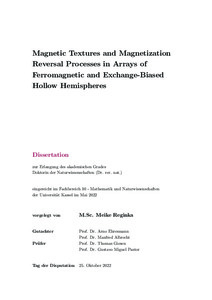| dc.date.accessioned | 2023-01-23T10:37:22Z | |
| dc.date.available | 2023-01-23T10:37:22Z | |
| dc.date.issued | 2022 | |
| dc.identifier | doi:10.17170/kobra-202212237262 | |
| dc.identifier.uri | http://hdl.handle.net/123456789/14382 | |
| dc.language.iso | eng | eng |
| dc.rights | Namensnennung - Nicht-kommerziell - Weitergabe unter gleichen Bedingungen 4.0 International | * |
| dc.rights.uri | http://creativecommons.org/licenses/by-nc-sa/4.0/ | * |
| dc.subject.ddc | 530 | |
| dc.title | Magnetic Textures and Magnetization Reversal Processes in Arrays of Ferromagnetic and Exchange-Biased Hollow Hemispheres | eng |
| dc.type | Dissertation | |
| dcterms.abstract | The main objective of this thesis is to investigate hemispherical caps prepared by thin film deposition of magnetic material compositions on top of nano- and micrometer sized silica spheres. When compared to flat magnetic discs, these microcaps differ in their magnetic properties due to the curved and therefore three-dimensional shape. However, under certain conditions, both microstructures have previously been proven to express the famous magnetic vortex texture because of the confinement into a circular shape. Vortices, in which the magnetic moments curl around the object’s center, are not only fundamentally studied to this day but are also traded as potential information carriers in spintronic devices. Aside of purely ferromagnetic caps, the focus of this thesis lies on cap structures exhibiting an exchange bias (EB). This effect emerges as an additional unidirectional magnetic anisotropy due to exchange coupling when a thin antiferromagnetic and ferromagnetic material share an interface. While it is aimed to study whether the effect’s characteristics known from flat bilayers are influenced when the film is structured into an array of curved microobjects, it shall also be investigated how the remagnetization of the caps - including the passing through various characteristic magnetization textures - is altered by the presence of EB. Throughout the work, the structural and magnetic properties of assembled magnetic cap arrays are experimentally studied to identify methods to tailor the exhibition of specific magnetic textures and remagnetization paths: e.g., the cap’s diameter, the ferromagnetic material, the presence or absence of EB, and post-deposition treatments. But most importantly, the caps’ magnetization reversal is studied in dependence on the ferromagnetic thickness which turned out to be a key parameter influencing both the EB strength and the demagnetization energy of the magnetic states expressed within the microcaps. Last but not least, it is found that the thickness of the antiferromagnetic layer determines whether the macroscopic magnetization reversal of the caps follows a biased, i.e., simply shifted hysteresis, or whether they remagnetize viscously instead. | eng |
| dcterms.accessRights | open access | |
| dcterms.creator | Reginka, Meike | |
| dcterms.dateAccepted | 2022-10-25 | |
| dcterms.extent | ix, 172 Seiten | |
| dc.contributor.corporatename | Kassel, Universität Kassel, Fachbereich Mathematik und Naturwissenschaften, Institut für Physik | ger |
| dc.contributor.referee | Ehresmann, Arno (Prof. Dr.) | |
| dc.contributor.referee | Albrecht, Manfred (Prof. Dr.) | |
| dc.contributor.referee | Giesen, Thomas (Prof. Dr.) | |
| dc.contributor.referee | Pastor, Gustavo Miguel (Prof. Dr.) | |
| dc.subject.swd | Magnetwerkstoff | ger |
| dc.subject.swd | Textur | ger |
| dc.subject.swd | Dünne Schicht | ger |
| dc.subject.swd | Silicium | ger |
| dc.subject.swd | Mikrostruktur | ger |
| dc.subject.swd | Wirbel <Physik> | ger |
| dc.subject.swd | Magnetische Eigenschaft | ger |
| dc.subject.swd | Array | ger |
| dc.type.version | publishedVersion | |
| kup.iskup | false | |
| ubks.epflicht | true | |


